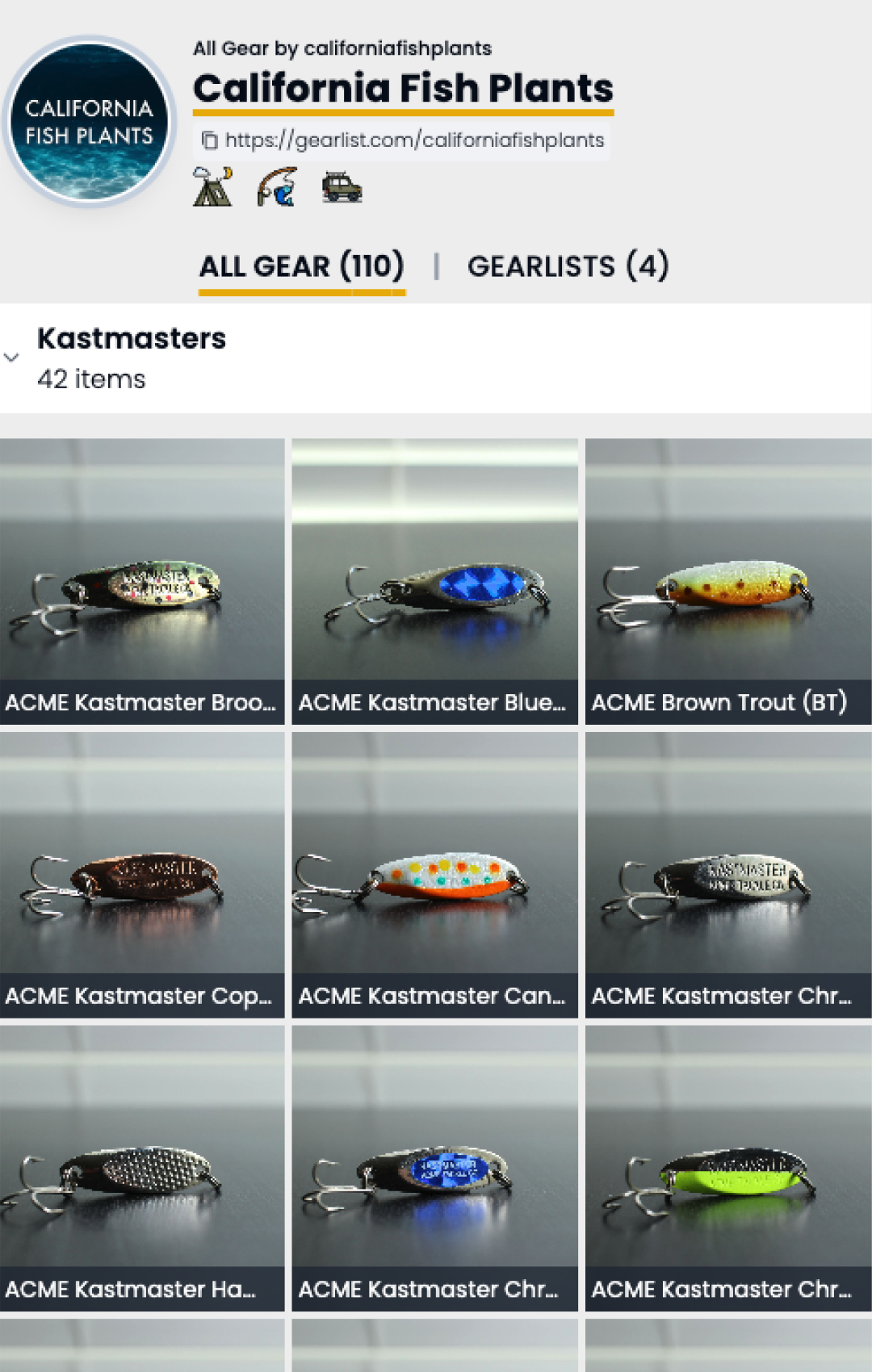Little Grass Valley Reservoir, tucked away in the picturesque Sierra Nevada foothills, beckons both seasoned anglers and those just dipping their toes into the fishing world. Positioned within the tranquil confines of Plumas National Forest, this reservoir isn’t just a camping spot—it’s a haven for fishing enthusiasts. In this guide, we’ll explore the abundant fish species that call these waters home, share some historical insights, offer essential tips for beginners, and provide strategies to make your fishing expedition here truly unforgettable.
📈 Latest Fish Plants
Fish here often?
How To Read Fish Plant Graphs
To interpret fish plant graphs effectively, consider the following key elements:
- Blue Vertical Bars and Numbers:
- Representation: The blue vertical bars on the graph represent individual fish plants.
- Weight Measurement: The associated numbers indicate the total weight of the plants in pounds (lbs.) that occurred during a specific week.
- Significance: Monitoring these bars helps identify weeks with higher planting activity, aiding anglers in selecting optimal times for fishing near recent plantings.
- Orange Trend Line:
- Purpose: The orange trend line represents the moving average of all fish plant activities at the specified location.
- Indicator of Activity: A rising trend line suggests a consistent increase in planting activity over the designated period. This indicates the potential for more catch opportunities and signifies a growing fish population over the weeks.
- Interpreting the Moving Average:
- Upward Trend: A rising moving average implies an upward trajectory in planting activity, indicating an increasing number of fish being introduced into the area. This suggests a positive outlook for anglers, as it implies a larger and potentially more accessible fish population.
- Downward Trend (Not Specified): The description does not provide information on the interpretation of a decreasing trend in the moving average. It might be beneficial to include information on what a decreasing trend could signify in terms of fishing prospects.
- No Data Present:
- Possible Explanations: If no data is visible on the graph, it may indicate that the location had no fish plants in the last three months. Alternatively, the absence of data could be due to non-disclosure of fish plants for that location.
- Natural Population: Some fishing areas in California rely on the natural growth of fish populations, and graphs may not show plants if this is the case.
- Graph Disclaimer:
- Data Source: The graphs reflect a combination of publicly disclosed data and estimates. Some locations may disclose fish plants without specifying exact amounts.
- Not Universal: Not all fishing areas have fish plants, and the natural growth of fish populations plays a significant role in many California fishing locations.
Understanding these elements will empower anglers to make informed decisions about when and where to fish based on historical fish plant data.
Note: If no data is present in the graph above, this location may not have had any plants the last 3 months, or may not have publicly disclosed plants. Graphs reflect both publicly disclosed data and estimates, as some locations disclose plants, but not exact amount.
🗺️ Map & Fishing Location
Diving into the depths of Little Grass Valley Reservoir, you’ll find a diverse array of fish species awaiting your hook. From the vibrant Rainbow Trout, eagerly snatching up various baits and lures, to the elusive Brown Trout lurking in deeper waters, there’s no shortage of excitement for anglers of all skill levels. And let’s not forget the charming Kokanee Salmon, best caught during the tranquil moments of early morning or late evening.
Steeped in history, Little Grass Valley Reservoir has earned its reputation as a prime fishing destination over the years. Anglers have long favored trolling for Rainbow Trout with specialized setups, reeling in impressive catches that could rival any fish tale. And with kokanee reaching sizes of up to 16 inches by midsummer, the potential for a memorable catch is ever-present.
For those embarking on their first fishing expedition to Little Grass Valley Reservoir, we’ve curated a list of top tips to ensure a successful outing. From choosing the optimal season to selecting the right gear and exploring strategic fishing locations, these pointers will set you on the path to angling success. And if you’re feeling uncertain, don’t hesitate to enlist the expertise of a local guide who knows these waters like the back of their hand.
When it comes to optimizing your fishing experience at Little Grass Valley Reservoir, strategic planning and the right gear are paramount. Whether you’re targeting trout in the spring, chasing kokanee in the summer, or exploring the depths with leadcore lines, there’s a tactic to suit every angler’s preference. And with our curated list of recommended fishing gear, you’ll be well-equipped to tackle whatever the reservoir throws your way.
In the heart of the Sierra Nevada foothills lies a fishing paradise waiting to be discovered. Little Grass Valley Reservoir isn’t just a destination—it’s an invitation to immerse yourself in nature’s bounty. By following our guide and embracing responsible fishing practices, you’ll not only reel in your next big catch but also contribute to the preservation of this pristine environment for generations to come.
Types of Fish in Little Grass Valley Reservoir
- Rainbow Trout: The most abundant fish, averaging 12-16 inches, readily taking a variety of baits and lures. Dry flies, nymphs, and PowerBait are all effective.
- Brown Trout: Less common but larger (18-20 inches), typically found in deeper waters. Bait fishing with live minnows or trolling with small Rapalas are effective methods.
- Kokanee Salmon: Smaller than other trout species, averaging 10-12 inches. Best caught trolling small spoons or spinners near the surface in the early morning or late evening.
- Other Species: Occasional catches of smallmouth bass and catfish are possible.
History of Little Grass Valley Reservoir
Little Grass Valley Reservoir, situated in the Plumas National Forest, has earned its reputation as a standard trolling/hardware lake. Anglers often use boats, rigged with flashers trailing a night crawler, and troll slowly for rainbow trout in the foot-long class. By midsummer, kokanee can reach 16 inches in length, and many good-sized rainbows and browns are taken each year, some approaching five pounds. The biggest rainbow trout documented approached an impressive 19 pounds.
Top 5 Tips for First-Time Anglers at Little Grass Valley Reservoir
- Choose the Right Season: Spring (April-May) and fall (September-October) are prime times to target trout, while early summer is best for kokanee salmon.
- Optimal Gear Selection: Light to medium-weight spinning gear is ideal for most species. Fly anglers should use light to medium-weight fly rods with floating lines for dry fly fishing and sinking lines for nymphing.
- Explore Specific Locations: Dam area for deep-water fishing, North shore for fly fishing, South shore for rocky and wind-protected shore fishing, and Inlet creeks like Tooms Creek and Ice Creek for smaller rainbow trout.
- Check Fishing Regulations: Before heading out, ensure you’re aware of and compliant with current fishing regulations.
- Consider Hiring a Guide: For specific fishing advice and assistance, consider hiring a local guide familiar with the nuances of Little Grass Valley Reservoir.
Top 5 Strategies and Tactics for Optimal Fishing
- Seasonal Timing: Plan your visit in spring or fall for optimal trout fishing and early summer for kokanee salmon.
- Time of Day Matters: Arrive early in the morning or late in the evening for the best fishing experience.
- Utilize Leadcore Lines: In summer, when fish descend to the thermocline, use leadcore lines to reach 35–40 feet deep.
- Bait and Lure Selection: Tailor your bait and lure selection based on the targeted species and their preferences.
- Experiment with Trolling: Trolling with flashers and nightcrawlers is a popular and effective method on this reservoir.
Top 5 Recommendations for Fishing Gear
- Rods: Medium-weight spinning rods for most species, with a selection of fly rods for fly fishing.
- Reels: Spinning reels matched to your rods, and fly reels for fly fishing.
- Lures: Include a variety of lures such as Rapalas, spoons, and spinners for different fishing conditions.
- Lines: Have both floating and sinking lines for fly fishing. Consider leadcore lines for deeper trolling.
- Explore Our Gearlist: Visit our Gearlist account for specific recommendations on fishing gear to maximize your angling experience at Little Grass Valley Reservoir.
Little Grass Valley Reservoir, with its tranquil waters and abundant fish population, offers more than just a fishing experience—it’s a gateway to unforgettable moments in nature. As anglers cast their lines and immerse themselves in the beauty of Plumas National Forest, they become part of a timeless tradition, where the thrill of the catch meets the serenity of the wilderness.
Reflecting on the rich history and diverse ecosystem of Little Grass Valley Reservoir, it’s clear that this destination holds a special place in the hearts of anglers far and wide. From the thrill of reeling in a Rainbow Trout to the peaceful moments spent by the water’s edge, every visit leaves a lasting impression, woven into the fabric of cherished memories.
As we take one last look at the shimmering waters of Little Grass Valley Reservoir, it’s impossible not to feel a sense of gratitude for the experiences shared and the connections made. Each ripple on the surface tells a story of adventure and camaraderie, reminding us of the simple joys found in the great outdoors.
With our fishing rods packed away and our gear stowed, we depart from Little Grass Valley Reservoir with a renewed appreciation for the natural world and a commitment to its preservation. As stewards of these pristine waters, it’s our responsibility to tread lightly and leave no trace, ensuring that future generations can enjoy the same wonders that have captivated us.
Though our time at Little Grass Valley Reservoir may come to an end, the memories we’ve created will linger on, inspiring future fishing expeditions and outdoor adventures. As the sun sets on another day spent in nature’s embrace, we carry with us the lessons learned and the bonds forged, knowing that the magic of this place will always beckon us back.
So, until next time, may the waters of Little Grass Valley Reservoir continue to teem with life and the spirit of exploration. And may each angler who casts their line here find not only fish but also a renewed sense of wonder and appreciation for the beauty that surrounds us.



